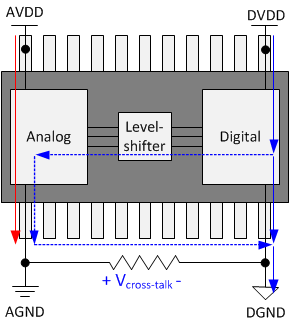- Ask a related questionWhat is a related question?A related question is a question created from another question. When the related question is created, it will be automatically linked to the original question.
This thread has been locked.
If you have a related question, please click the "Ask a related question" button in the top right corner. The newly created question will be automatically linked to this question.
I am laying out a PCB that uses a precision 24-bit ADC. What are TI's recommendations for PCB layout?
Also, should I split the ground plane between analog and digital circuits?
Our datasheets usually contain a Layout Guidelines section...
as well as a Layout Example...
There are two common approaches to PCB grounding when working with mixed signal devices:
While there is no one right way of laying out a PCB, we see some advantages to using the 2nd method (the single-ground plane):

[EDN] Design PCBs for EMI, part 1: How signals move
[EDN] Design PCBs for EMI, part 2: Basic stack-up
[EDN] Design PCBs for EMI, part 3: Partitioning and routing

